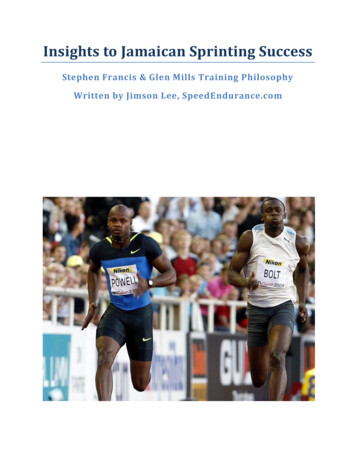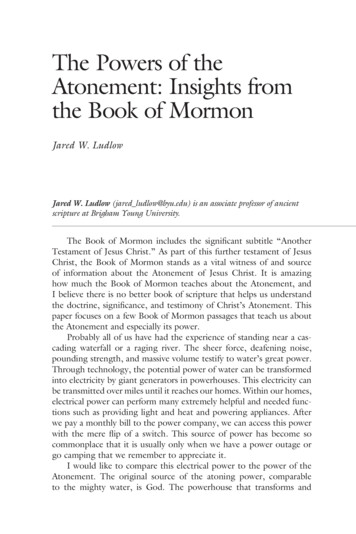
Transcription
Insights to Jamaican Sprinting SuccessStephen Francis & Glen Mills Training PhilosophyWritten by Jimson Lee, SpeedEndurance.com
ContentsIntroduction . 3Disclaimer. 3About this Report . 3About the Author . 3Stephen Francis Training Philosophy . 4Long to short, or Short to long program? . 4GPP Setup and Periodization . 4Training Specifics (on Sleds, Sand, Overspeed, Hills and Spilt Runs) . 5On Training . 6A Typical Training Week: . 6Weight Training and Drills. 8Testing Week, Easy Weeks . 9Why the 400m early in the Season? . 10Changes in January, and Training on the track . 11Competition, Peaking and Taper. 11Training Mentors and Support Staff . 12On Hurdles . 12Glen Mills Training Philosophy . 13IAAF New Studies in Athletics Interview with Glen Mills* . 16Usain Bolt Stack Magazine Interview (September 1, 2008). 27Stephen Francis on the Women’s 100m Hurdles Breaking 13.00 Seconds . 28Pages 1-14 Copyright 2011 by Jimson Lee, SpeedEndurance.comPage 2
IntroductionDisclaimerThis report is free of charge. You may freely distribute this as long as you do not charge for it. You maynot change or modify any of the content, including the links.If you wish to receive more of these reports, please sign up at http://speedendurance.com/newsletter/About this ReportBy 2009, if there were 2 coaches in Jamaican Sprinting that comes to mind, it’s Stephen Francis andGlenn Mills. Athletes such as Asafa Powell or Usain Bolt are now household names, thanks to them. Butit doesn’t stop there. They have success in the women’s sprints, as well as hurdles. So it’s more thanjust getting lucky with 2 freak athletes.So what’s their secret? If you want to run fast, you can either innovate, or imitate!This report will attempt to show some insight on what they do, and most importantly, why.A coach is measured by results, not by knowledge. So please read carefully and apply their knowledgeto your training program.About the AuthorJimson LeeJimson Lee is a Coach, Masters Athlete and founderof the Blog SpeedEndurance.com which receivedover 1.5 million visits in 2010.SpeedEndurance.com articles have been quoted inESPN, BBC, NY Times, Yahoo Sports, SportsIllustrated, Yahoo’s College Football, San JoseExaminer, and Wikipedia.org.The articles were also referenced in the printededition of ESPN Magazine and The Globe and Mail,Canada’s National newspaper.Zen Habits ranks SpeedEndurance.com as one ofthe 20-plus Amazing Fitness Blogs to Inspire You.Pages 1-14 Copyright 2011 by Jimson Lee, SpeedEndurance.comPage 3
Stephen Francis Training PhilosophyLong to short, or Short to long program?This is the classic question for sprint coaches. A Long to Short approach is using high volume and overdistance training at slower speeds early in the season. As the season progresses, you get into morespecific, faster running at shorter distances.A Short to Long approach starts on day 1 as you start acceleration development from week 1. Eliteathletes will typically start this in October and sometimes November. These athletes will do well with 60meter indoor competitions in the winter.Francis’ training plan is a high volume, short recovery leading on to lower volume and longer recovery asthe season progresses. He doesn’t do much low intensity work as he “read in a book” a while back thatto run longer than 20 minutes will affect your speed. Thus his longest run for conditioning is 20minutes.So to answer the question, Francis training plan is a long to short approach with short to long in it. Thatis, the short 30 meter sprint is there all year long.While a lot of traditional coaches train their athletes hard 3 days a week, training hard 4 days a weekdoes present its challenges. Francis believes you can work hard on successive days if you are workingdifferent energy systems. For example, short sprints to 30m one day, and then speed endurance thenext day. This makes sense as the CNS requirements for speed endurance is not as high as in shortspeed work.One of the unique training weeks in the macrocycle is Francis’ group does 15 sessions in a week,because he “read a book” by Frank Dick a while back that said you need 15 sessions/week. This volumeand stimulus is more important than any theory about CNS and its recovery. It works for his group. (seea typical training week below)In terms of training women, they do the same workouts with 20% less volume than the men.As a group, the youngest athlete is 17 years old.GPP Setup and PeriodizationIf you think Jamaica is a party town, think again. At least not for MVP (Francis’ Track Club). Francis’group AM workouts start at 5am. That’s not a typo. The reason is to control the nighttime activities (i.e.parties) of athletes. With a 5am start, you are in bed pretty early! Or you will be in a land of hurt.His macrocycle is a typical 3 week hard and 1 week easy where the easy week is a testing week.Pages 1-14 Copyright 2011 by Jimson Lee, SpeedEndurance.comPage 4
Regarding Periodization, it depends on several factors such as the climate and facilities. Francis’ grouphas 1 long peak from April to September. He doesn’t believe it is possible to peak for indoors and thenpeak again for Jamaica Trials in June.So GPP (General Preparation & Planning) is 4 months long, starting in September but the professionalathletes start in late October or sometimes even November. This phase will go till March and willinvolve (at a high level detailed plan to follow later in this article): Hill sprints:Weights:Twice a week4 times a weekOnly after March, he introduces speed endurance.For more info on Peaking, Planning and Periodization, lanning-and-periodization/Training Specifics (on Sleds, Sand, Overspeed, Hills and Spilt Runs)So what does Francis do to improve the acceleration development in the first 30 meters of a 100msprinter?Basically, they do sled work for 6 months. In terms of weights, he uses up to 50 lbs or 23 kg for menand 25 lbs or 11 kg for women. Asafa Powell can run 2.86s for 20m in flats, and 3.45s with a 50 lb sled!This is on contrast to some coaches who like to use a maximum of 10% of their body weight.As far as sand runs goes, you would think it would be extremely popular having Jamaica as a year roundtraining camp! However, he doesn’t like sand runs for two reasons. One is their training center is anhour away from the beach. The other is sand runs stress the quadriceps too much.Another training method Francis doesn’t like is overspeed training as the chance of injury is too high!If you want more information on overspeed training, -training-controversy-good-or-bad/The reason is the athlete loses too much control at the higher velocities. Staying healthy is the numberone priority. Even sprinting 60 meters is risky as the 50-60m segment traditionally has a high chance forathlete to pull up. (more on alternatives to 60m training later)The hill session that Francis describes is an extremely steep incline at near 45 degrees for the first part ofthe hill, then it levels off slightly. The total distance is 150 meters, and they do repeats with a walk backdown the hill in approximately 5 minutes.Pages 1-14 Copyright 2011 by Jimson Lee, SpeedEndurance.comPage 5
For Sherone Simpson, her PB for 150 meters on the track is 15.8 but runs the hills in about 22 seconds.(That must be one steep hill!)And finally, he likes to avoid split runs (i.e. 200m 200m) but he will use it sometimes if a sprinter is lazyon a single rep.On TrainingFrancis doesn’t have anyone in his group go all-out with their top-speed in training. Not even in hisshort 30 meter runs. All runs must be controlled.As mentioned above, he does 30 meter runs from Day 1, along with sleds, hills, plyometrics and weighttraining.While he does short speed from day 1, his long to short training workouts include medium intensity“intensive tempo” program such as 5x300m with 10min rest at 38-39 seconds on a 300m (2-turn) grasstrack.Jamaica loves their 300 meters, and even up to the last week or two before a major championship, hemakes his athletes run a 300m or 250m in practice. Asafa Powell has run 32.8 on a grass track with flats!Why 300m?Just like the 40 yard dash in American football, the 300m is a must. Because the 300m is traditional inJamaica, your 300m time is equally important as your 150m time.In 2011, according to Glen Mills, Yohan Blake ran “30 point something” seconds for the 300m in trainingbefore his 19.26 PR for the 200 meters, which is just outside the world record.Francis really dislikes the 60m in practice. His main work is 30 meters, but he will get up to 2 x 50m. Butnever 60m, because he’s seen too much damage a 60m based on experience. For speed endurance, hedoes 80, 90 and 100s, but that’s because the speed is slower.A Typical Training Week:His team does all running in flats until February. Classic workouts include: 8x300m with 5 min rest12x200m with 3 min restThese workouts are performed twice a week.Pages 1-14 Copyright 2011 by Jimson Lee, SpeedEndurance.comPage 6
Like most traditional coaches, his 300's are his favorite workout and should be done every week. First,it helps your technique as you will learn to run efficiently over repeat 300’s. If you have bad form, trustme, you will learn to correct it real fast. The other reason for this workout is to develop a resistance topain.For short sprints, there are 2 sessions a week, which include starting blocks and correctingbiomechanics, sled work, sled work from blocks for distances between 20 and 30m.He’s also a firm believer in circuit training one day week, which goes on until December.So here is a sample weekly training schedule:Mondays5am Hill sprints to 40mStretchingAb work3pm WeightsPlyometricsTuesday5am Long speed endurance400's, 350's or 300's(or 800's, 600's, 500's for 400m athletes). No more than 6 reps done here.Ab workMed Ball3pm Technique work (mainly drills and some form runs)Wednesday5am Long hills250m, 200m or 150m(300m for 400m athletes). No more than 8 reps done here.Pages 1-14 Copyright 2011 by Jimson Lee, SpeedEndurance.comPage 7
3pm WeightsThursday5am Circuit training (bodyweight exercises - burpees, press ups etc)Drills for enduranceMed Ball3pm Technique work (mainly drills and some form runs)Friday5am Sled workStretchingAb work3pm WeightsPlyosSaturday5am WeightsSlow speed endurance or intensive tempo such as 200's3pm RestSunday RestWeight Training and DrillsPages 1-14 Copyright 2011 by Jimson Lee, SpeedEndurance.comPage 8
Francis prefers weight training with mostly free weights and very little machines. That’s because hebelieves the training should closely resemble the sprinting action as possible, therefore he goes withsplit squats, single-leg deadlifts, lunges, steps up, one-legged squats and all that “one-legged stuff”.There is one caveat: NO TRADITIONAL SQUATTING!But if he is going to do squats, it will be a front squat, so the weight can be thrown forward in case ofemergency. Variations include jump squats and split jumps.He prefers to do weights before a sprint session (i.e. see a typical Saturday workout above)They even do lots of cleans, mostly from the hand position. They do not do the full clean and jerk northe snatch.Core work is done 3 times a week with a large amount of ab work is done with a medicine ball.He likes the bench press because it strengthens your hands and arms to hold you up in the SET position.What is particular about the choice of weight exercises is he like sot focus on the back of the body, thatis from the heel all the way up the lumbar part of the lower back, as these are the muscles mostinvolved in sprinting.He believes sprinting is very stressful on the hamstrings. Thus, he'll perform
Stephen Francis Training Philosophy Long to short, or Short to long program? This is the classic question for sprint coaches. A Long to Short approach is using high volume and over distance training at slower speeds early in the season. As the season progresses, you get into more specific, faster running at shorter distances.











